Prague is located in the center of Bohemia, on both banks of the Vltava River. It has been the political, cultural and economic center of Czechia for 1000 yearsAs the 6th most visited city in Europe after London, Paris, Rome, Madrid and Berlin, Prague, one of the most popular tourist centers in the world, is a smaller city than the others, with its cobblestone streets and historical points that invite time travel. crowded.
Also known as the ‘City of a Thousand Towers’, Prague’s 1100-year-old skyline consists of ancient towers towering over the roofs of countless magnificent churches, making the city one of Europe’s most precious jewels. Everywhere you look, it’s adorned with the best of gothic, baroque, Renaissance and new art styles, contrasting with the intact ancient Prague Castle.
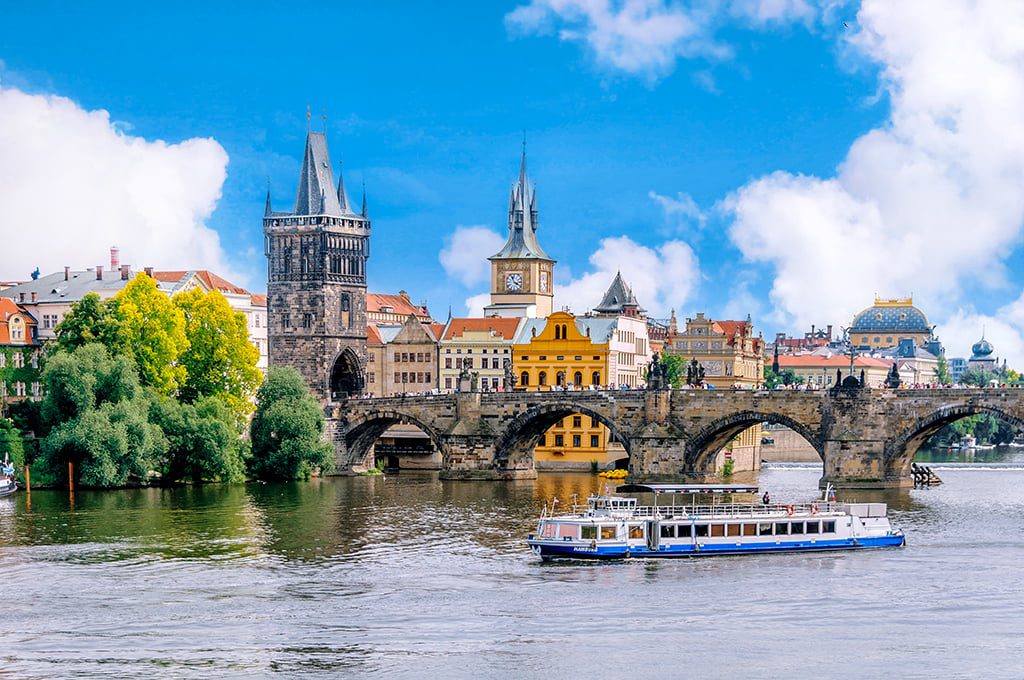
Prague, which is also known as the city with 100 towers due to the large number of churches on both sides of the river, II. Since it survived World War II with only one bomb, it managed to preserve its architectural features. That’s why the city is almost like an open-air museum.
With its towers, magnificent cathedrals, elegant palaces, statues that adorn every part of the city, large squares, impressive bridges lined up over the river, it makes you feel as if you are traveling in the Middle Ages.
30 years ago, Prague was one of the mysterious cities of Europe. It has now become one of the most popular tourist destinations, attracting 4 million visitors each year. The city’s centuries-old historical past, its magnificent structures of Roman, Gothic, Baroque and Renaissance architecture, numerous palaces, churches, parks, squares, delicious food and, of course, reasonable prices have a great impact on this increase in visitors.
Prague Travel Guide
There are only a few cities in Europe as beautiful as Prague, so much so that the old world look of the city is just one of its features. In the city, during the centuries of bohemian kings, classical music composers, invading Nazis, Soviet tanks and velvet revolutionaries have witnessed history.
The historical center of Prague, which has the most beautiful and romantic city skyline in Europe, including the Old Town (Staré Město), Lesser Square (Malá Strana) and New Town (Nové Město), was included in the UNESCO World Heritage List in 1992. In the Czech capital where you can fall in love, you can drink world-class beers and fall into the clutches of different architectural mixes from gothic to cubism.
Today’s Prague is famous for its artistic texture, dinners and live entertainment as well as its architecture. Food, drink and night entertainment are the city’s daily routine, along with exquisite galleries, major museums and crazy nightclubs.
A temperate continental climate is seen in Czechia and Prague, which is located in the interior of Europe. The city is cold and humid in winters and hot in summers, while springs are warm. May, June and September are the best months to visit Prague, which is generally slightly cooler than Istanbul.
Prague Attractions
Prague is a city that can be explored on foot in terms of its proximity to places to visit. You will not need public transport too much because it is very easy to reach the touristic places on both sides of the Charles Bridge (Karl Bridge) on foot.
Staré Mesto, Malá Strana, Hradcany and Nové Mesto, which are the most important attractions in Prague, are within walking distance of each other. Other than these, you can reach them by tram and metro after 5-10 minutes of walking from your location.
Urban historical areas generally consist of museums, churches, parks and squares. In Prague, which is the capital where the buildings of the 14th and 18th centuries are best preserved among European capitals, the majority of the center is under protection as a World Heritage Site.
Prague is more than just a magnificent architecture. Towers, columns and pillars in almost every building create a festive atmosphere regardless of the season. One of the best things to do is to get lost in the streets and breathe the festive atmosphere without any route in mind. Hundreds of other visitors who are there for the same reason make it easy to feel that there is something very important around.
1. Stare Mesto and the Astronomical Clock
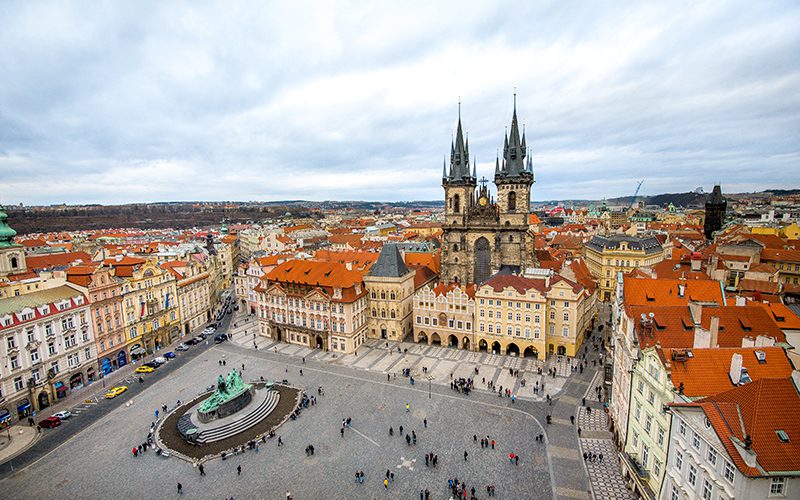
Stare Mesto is one of the oldest settlements dating back to the 10th century. Today, the square, where restaurants, cafes, souvenir shops are located, and all kinds of architectural styles can be seen, has not undergone much change since its foundation in the 12th century and when the city functioned as a market place. Prague’s historic center is one of the best places to start exploring the city.
The places to be seen in Stare Mesto are the Astronomical Clock and Stare Mesto Town Hall, the Church of Our Lady, St. Nicholas Cathedral, the House with the Black Madonna, Goltz-Kinsky Palace, Clam-Gallas Palace, Clementinum and the Jewish Quarter.
The Old Town Hall (Staromestská radnice) is home to the exquisite 15th century Astronomical Clock, where every hour the 12 Apostles and other figures appear on the face of the clock. Other landmarks in the Old Town Hall are the chapel built in 1381, the Gothic entrance that opens to a remarkable interior with art exhibits, and the former prison. To enjoy the unique view of Prague, you can go to the top of the Old Town Hall Tower by stairs or by elevator if you prefer.
The Prague Astronomical Clock was made in 1410 by a clockmaker who was also a professor of mathematics. The clock, known as the Orloj, is the third oldest clock in the world. It shows different Babylonian, Bohemian and German times. It also gives information about the sidereal hour, sunrise and sunset, moon phases, and the sun’s position in the zodiac.
In 1865, figures of the apostles were added to the two windows above the clock. These windows are opened at the beginning of every hour and the apostles take turns passing by the windows to the accompaniment of the chiming bell and the crowing of the rooster. At the same time, the figures around the clock begin to move.
2. Tyn Church
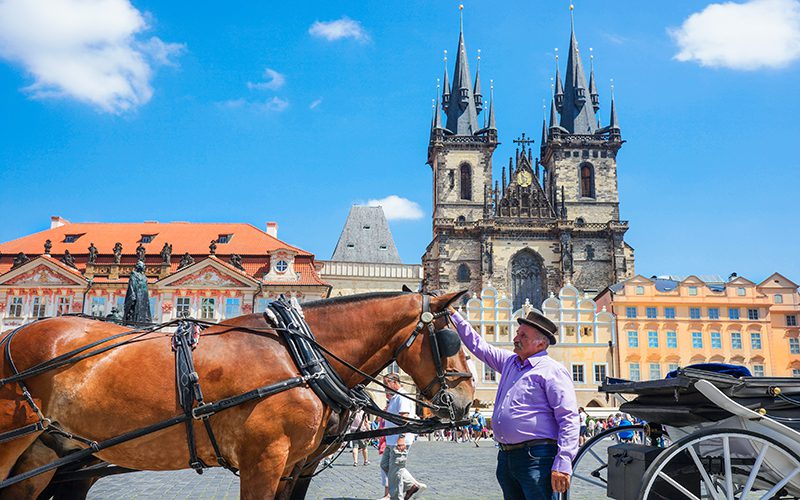
Tyn Church is located in the heart of Prague old city center Stare Mesto. One of the most beautiful buildings in Staromestske Namesti Square. The twin towers you see on the Prague skyline belong to this church. Although it was completed in the 15th century, it continued to be changed over time.
The main entrance of the church, which is reached by a small passage between the houses, contains the tombs of many important figures in Czech history, as well as the crucifixion statue and early Baroque paintings from 1649. The magnificent Gothic north gate and the most beautiful organ in Europe should not be overlooked.
After the church, you can visit the 11th century Ungel Courtyard behind the church, with many fine cafes and restaurants. Another church worth seeing is the Baroque Church of the Virgin Mary, with its famous statue of baby Jesus believed to have performed miracles, which continues to be one of the pilgrimage points.
3. Prague Town Hall
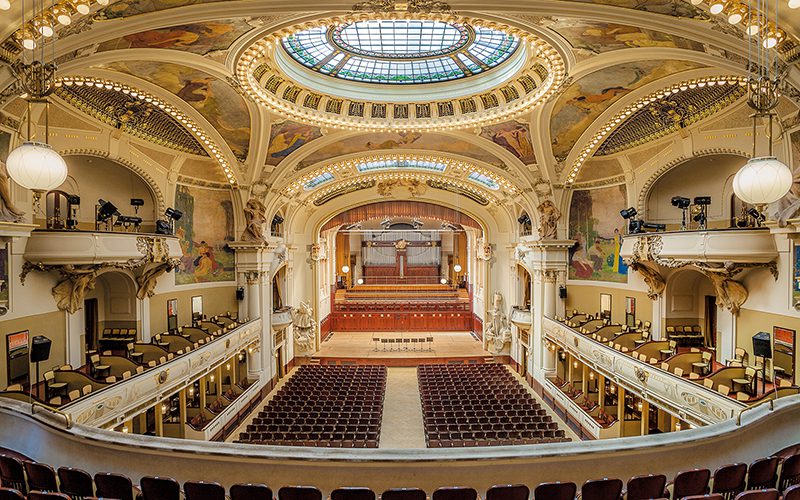
Prague Town Hall (Obecní dům) is one of the best examples of the new art movement in the city. The magnificent town hall, built in 1912, is also home to Smetana Hall, one of Prague’s largest and most important concert halls.
The concert hall is dazzling with its numerous striking features, such as the mural that starts over the second floor balcony arch and covers the large dome. It is a very impressive building with its magnificent stained glass windows and important paintings in the interior. If you visit with guided tours, it is also possible to see the normally closed ceremony room.
4. Jewish Quarter
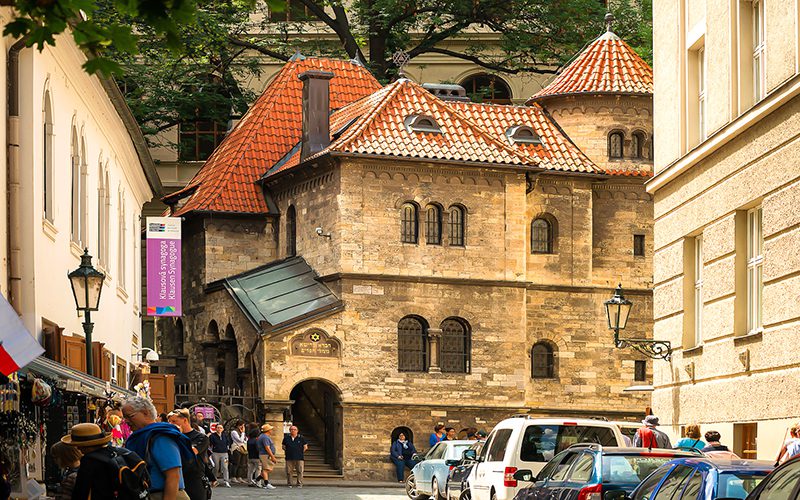
The Prague Jewish Quarter (Josefov) is a 13th-century area where Jews from Prague lived surrounded by walls for 500 years. While it was considered a suburb of that period in the 1200s, when most of the neighborhood was demolished in order to make Art Nouveau style apartments in the 1800s, it became one of the most interesting and important areas of the city with its transformation.
Josefov Jewish Museum, Old Jewish Cemetery, Bohemian Virgin Mary Church, Old-New Synagogue, Jewish Town Hall, Klaus, Maisel and Pinkas synagogues are among the places to see.
5. Clementinum and the National Library
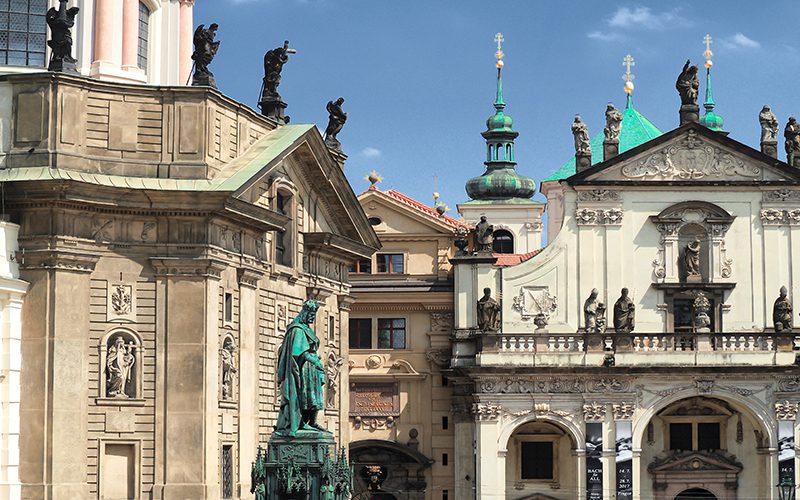
Clementinum , which has one of the largest collections in Europe , is also home to the Czech Republic National Library. While these beautiful baroque buildings were part of the Jesuit College, they later became the home of the Jesuit book collection and the Karolinum collection. Becoming state property after the Jesuits were deported, it became a public library in 1782, shortly after it was designated the National Library.
With more than 6 million books and a copy of every book published in the Czech Republic, Clementinum is home to an enormous collection. The delicately beautiful Baroque library hall with its fine ceiling art, the 68-metre-tall Astronomy Tower and the ornate Mirrored Chapel stand out.
If you want to have an unforgettable experience in the structure that you can visit with guided tours in English, it should not be forgotten that the Clementinum is used for jazz and classical music concerts.
6. Charles Bridge
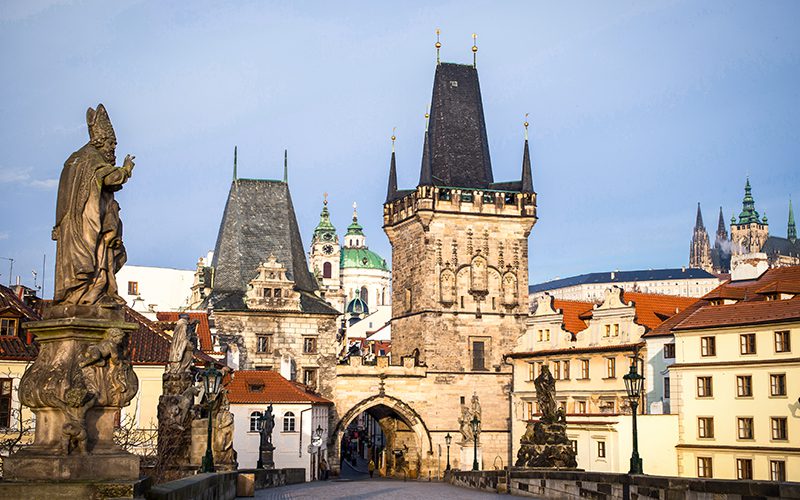
The magnificent Charles Bridge (Charles Bridge), one of the oldest known bridges in Europe , connects Mala Strana to Stare Mesto. The bridge, which has three towers, one of the most beautiful examples of Gothic style architecture, is 520 meters long and has 32 interesting features that are different from each other.
Built in 1357, the bridge has been the subject of superstitions for many years. Due to a series of numbers (135797531) believed to add extra strength to the bridge, the masters added the last stone on July 9, at exactly 05:31.
The bridge is also famous for its many unique statues, notably the statue of the Holy Roman Emperor Karl IV and the statue of John of Nepomuk, one of the country’s most revered saints. Another superstition is that rubbing the plate under the statue of John of Nepomuk grants wishes. Do not miss the views of the Vltava River and the Gothic gates of the bridge, which offer magical shots for photography enthusiasts.
7. Lennon’s Wall
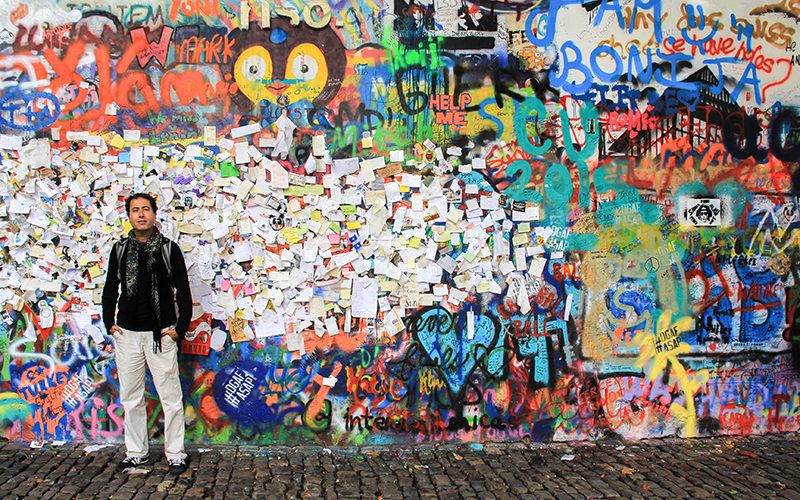
Perhaps one of Eastern Europe’s most intriguing venues, the Lennon Wall is a show of affection for Beatles member and peace ambassador John Lennon. With the murder of the singer in 1980, this wall near Charles Bridge unexpectedly became a billboard for Lennon fans to convey their pain, draw pictures and write slogans attributed to the artist.
Despite the efforts of the Czechoslovakian police under the communist regime to remove the graffiti, the memorial wall continues to preserve the lyrics of John Lennon and symbolizes peace and hope for the people of the city. The wall, which was the scene of John Lennon’s death anniversary gatherings, is also a place frequented by tourists.
8. St. Vitus Cathedral
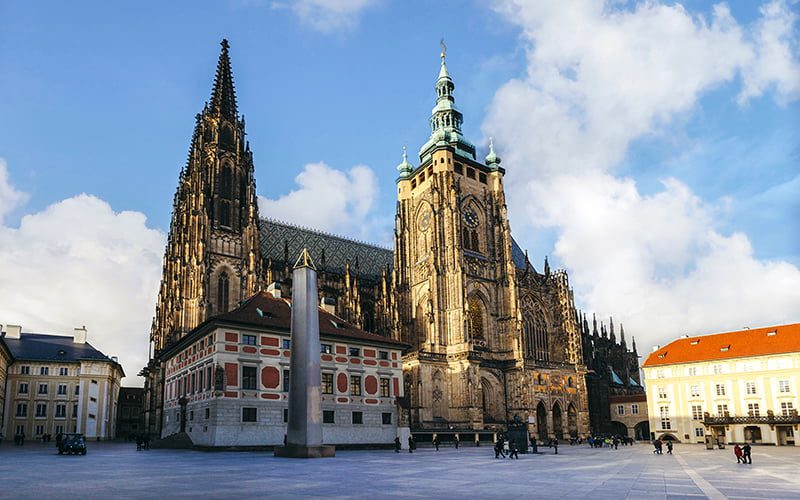
st. Vitus Cathedral (Kathedrala Svateho Vita) is a Roman Catholic church that you come across when you pass the first two courtyards of Prague Castle. One of the best examples of Gothic architecture with its pointed towers, the cathedral is the most striking structure of Prague Castle. Located in the Romanesque Rotunda area, built in 925, the construction of the cathedral began in 1344 and took more than 525 years to build.
Throughout its construction, it has become a blend of modern Neo Gothic and 14th century Gothic styles, influenced by the Baroque and Renaissance. The cathedral, which houses the Prague Archbishopric, contains the tombs of Bohemian kings and many national treasures.
st. Vitus Cathedral, known for its stunning stained glass glass, The Holy Trinity, with its altar covered with a dazzling 1,300 precious jewels and a mosaic from 1370 (The Last Judgment) are St. Wenceslas Chapel (Svatovaclavska kaple). Climb the cathedral’s 97-metre main tower for a magnificent view of Prague from another perspective.
9. Prague Castle
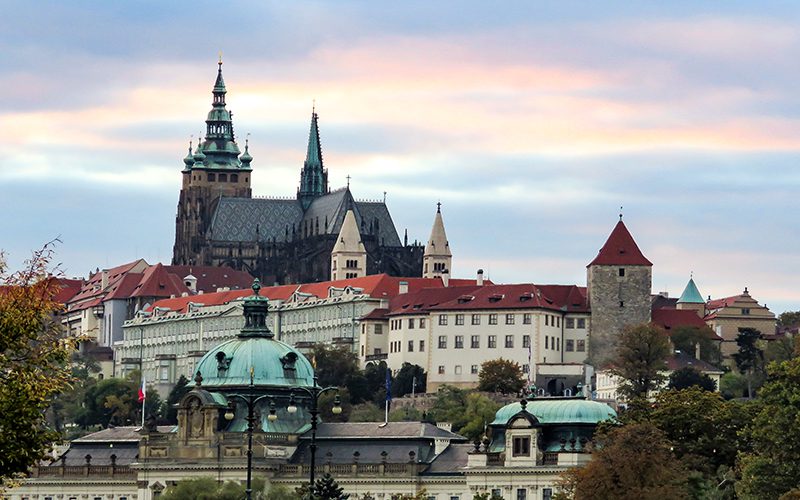
Prague Castle , home of bohemian kings in the Hradčany district of Prague , is now used as the official residence of the President of the Czech Republic. The castle, which is also the city’s most visited tourist attraction, was built in the 1970s and has changed dramatically over the years, hosting the leading architectural styles of the past millennium.
You need to spare a considerable amount of time to tour the huge complex, which is the largest ancient castle in the world, where you can watch the unique view of the Vltava River with its towers in the background. The highlights are the former royal palace and The Vladislav Hall, which is big enough to play spear tournaments and whose stairs are wide enough to be used by knights.
Don’t forget to spend time in the Royal Garden, which dates back to 1534 and houses many remarkable buildings such as the Ball Game Pavillion. The castle complex can be visited at any time of the year between 06:00 and 22:00.
10. Prague National Gallery
Located in the middle of the city’s most important architectural works, the National Gallery (Národní gallery v Praze) hosts one of the most important art collections in Europe. The artworks that make up a large part of the collection spanning from the 19th to the 21st centuries are housed in the Veletrzní Palace (Veletrzní Palác), a relatively modern building built in 1925.
Asian art and artifacts from antiquity are the other highlights of the collection, while the Baroque collection is exhibited at the Kinsky Palace (Palác Kinskych), and the medieval European artifacts are exhibited at the Bohemian St. Agnes Monastery.
11. Wenceslas Square
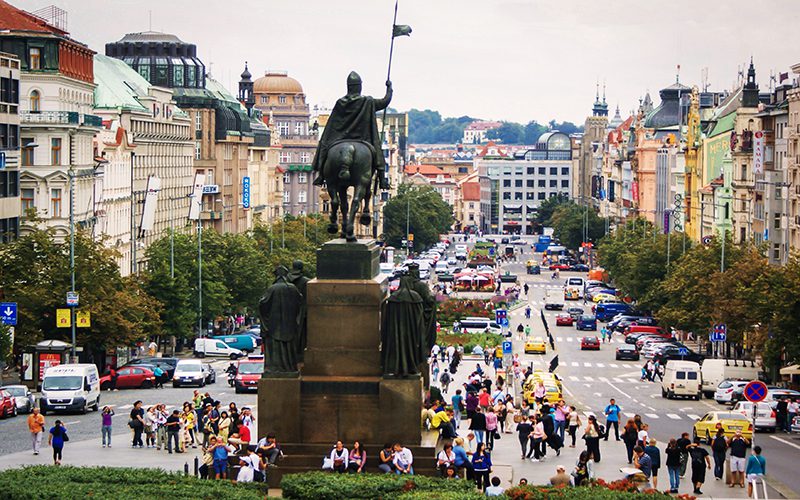
The highlight of Prague’s new city center (Nové Město), the magnificent Wenceslas Square (Wenceslas Square), is home to the National Museum and countless architectural treasures. Wenceslas Square, named after the patron saint of Bohemia and where his statue is located, was built as a horse market in the 14th century, when Charles the 4th reigned.
The square, which has been one of the important public spaces of the city since the 14th century, when it was built as a horse market, is also a frequent destination for tourists. Wenceslas Square, whose history dates back to ancient times, gained its current appearance in the 19th century. Today, while the square is the scene of protests and demonstrations, it also houses the city’s best restaurants and shopping venues.
12. The Dancing House
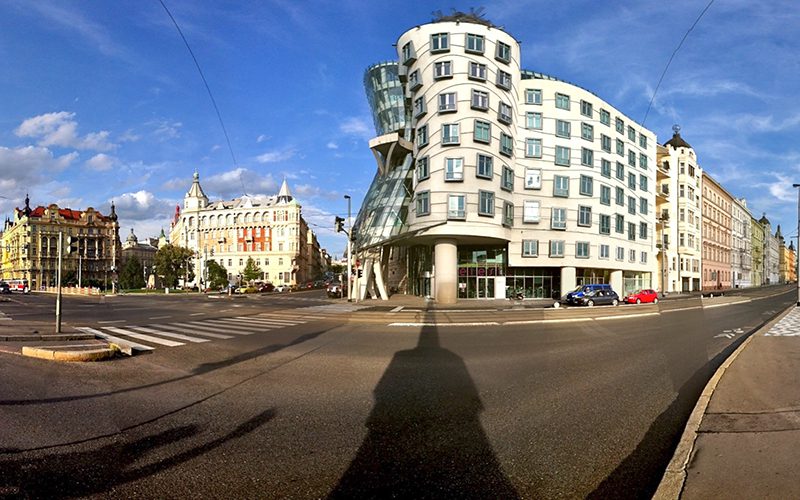
The Dancing House was built between 1992 and 1996 by Frank Gehry. The Dancing Building, known as Tancici Dum , is a striking example of modern architecture. Designed by the American architect Frank Gehry in the early 1990s, the building was built in the style of deconstructivism.
The building, which symbolizes the two dancing partners, was named Fred and Ginger after the famous American dance artists Fred Astaire and Ginger Rogers. The restaurant on the top floor of the building, which mostly consists of offices, has a beautiful view of the city.
If you haven’t been to this UNESCO World Heritage city yet and you only have time for a day trip, you can take a day trip from Prague to Cesky Krumlov .
On the Kutna Hora tour from Prague with a 6-hour excursion program, you can visit the famous Sedlec Ossuary, known as the ‘Bone Church’ with its human skull and bones. A 5-hour tour of Terezin Concentration Camp to embark on a different historical journey , World War II. It offers the opportunity to see the World War II camp and the Terezin Monument.
Prague eating and drinking
Although Prague’s cuisine is not very famous, the quality of the restaurants in the city has increased considerably with the inclusion of the Czech Republic in the European Union in 2004. With the introduction of international cuisines for the first time, there is now a wide range of menu options. The venues, which offer examples of classical Czech cuisine recommended by gourmets in high-end restaurants, as well as national delicacies, impress with their stylish decorations.
Knedliky, which resembles a ravioli made from wheat or potato flour, svickova, a meat dish with cream sauce, roast beef, vepřo-knedlo-zelo made of pork prepared with bread and special sauce, Prague ham, potato pancakes, potato and mushroom soup are among the things you should taste. If you are not open to new tastes, Turkish restaurants in the vicinity can come to your rescue.
In addition, Trdelnik, a Slovak dessert that you will encounter in almost every street around the old town, is among the foods that deserve to be tried. Czech desserts generally consist of pancakes or ravioli filled with fruit. Don’t miss the modern delicacies served with Czech beers at U Modre Kachnicky. U Vejvodu serves the best spicy goulash in Prague.
To experience these restaurants, which offer a beautiful view of the city, you should wait until the evening to dine, because what you need to do before is to start the day with coffee and cake in one of the old cafes of the city. Since the 19th century, Prague’s cafes have been a meeting point for artists and intellectuals, just like in Europe . The venues, many of which still preserve their former splendor, are waiting for their visitors for breakfast or lunch.
In Prague, which has a uniquely developed beer culture, it is possible to come across a small pub almost every step of the way.
Prague shopping
Although the products are not of very good quality, the pleasure of shopping along the Charles Bridge on the Vltava River is completely different. Street artists sell watercolor cityscapes, cheap jewelry, and souvenirs with Franz Kafka images.
The world’s best crystal and glass products (Crystals of Bohemia) are also sold in Prague. The windows of the shops in the Old Town square are full of dazzlingly beautiful items. Also, the best Czech beers that can be bought in Prague are. Becherovka, a Prague liqueur, can also be a nice gift.
Havel Market (Havelsky Trh), one of the oldest markets in Prague, has all kinds of vegetables, fruits, souvenirs, jewelry and toys. Second-hand goods are sold at the Prague Market (Prazska Trznice), established in Bubenske Nabrezi, where mainly Asian-made electronic goods and sports equipment are sold.
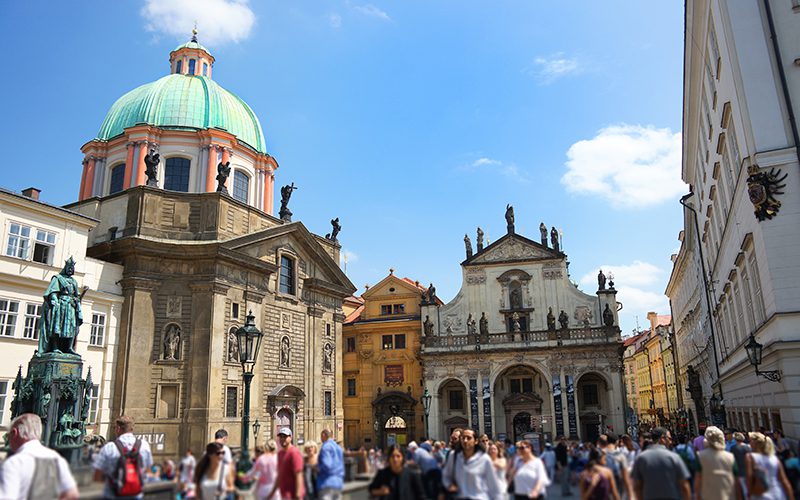
Prague nightlife
Since 1989, Prague’s entertainment life has become full of rich options. Do not leave without attending a puppet show and classical music concert in Prague, where the number of clubs, discos and bars is increasing rapidly, as well as puppet and pantomime shows, theater and classical music concerts.
It’s okay if the shows and performances are not in English, and there is no need to speak the language for great performances at the National Marionette Theatre. Music by Mozart and works by Czech musician Dvorak are regularly featured at concerts across the city. For an unforgettable evening at Smetana Hall or enjoy a cheap ticket to performances in the magnificent Old Town chapels.
Tretters for those who like luxury nightclubs in Prague, Buddha Bar, Bar and Books and Mumbai for stylish but more comfortable venues are the most popular places. You can also check out my Prague nightlife blog post.
Where to stay in Prague
Home to the city’s historic center and top attractions such as the Old Town (Staré Město), New Town, Lesser Town, Little Quarter (Malá Strana) and Prague Castle, staying in Prague 1 means you’re only a short walk from all these attractions. .
➤ Luxury Hotels : Hotel Residence Agnes is a historical building with its perfect restoration, just 600 meters from the Old Town square. Alchymist Grand Hotel & SPA is a boutique hotel located in a 16th century Baroque mansion very close to Prague Castle and Charles Bridge. The Four Seasons Hotel Prague is an elegant hotel just steps from the Charles Bridge, overlooking the Vltava River.
➤ Mid-Range Hotels : Boutique Questenberk is a quiet hotel near Prague’s largest park. Design Hotel Jewel Prague is a popular mid-range option located within a 20-minute walk of Prague Castle. The Ibis Praha Old Town and Prague Marriott hotels are a short walk from the Old Town Square. Appia Hotel , Hotel Pod Vezi and Hotel U Jezulatka in Malá Strana are alternative options.
➤ Affordable Hotels : Aparthotel City 5 offers modern apartment-style apartments, 10 minutes from Prague Castle. Miss Sophie’s Hotel and the modern B&B Hotel Prague City are other popular budget options within a 20-minute walk from the Old Town Square. The places I would recommend for hostel are Czech Inn Hostel and Hostel Orange . Sleep&Go , which is a great hotel in terms of price and performance, is quite good.

How to get to Prague
An important part of Prague’s charm is that it is a convenient place to visit at any time of the year. During the spring and autumn, the city usually reaches very hot central European temperatures in the summer, while the winters can be long and cold.
However, Prague has the perfect atmosphere for magnificent Christmas celebrations. While the city is brimming with tourists in July and August, it certainly welcomes fewer visitors in November, January, and February. You can choose the months of December and January, when the snow falls heavily, for the postcard-beautiful frames.
Turkish Airlines organizes direct flights from Istanbul Atatürk Airport to Prague Ruzyne Airport. You can fly to Prague Ruzyne Airport with direct flights of 2 hours and 40 minutes every day of the week from Istanbul Atatürk Airport with Turkish Airlines and from Sabiha Gökçen Airport with Pegasus Airlines.
You can use public transportation, minibus taxi, taxi and shuttle options to reach the city center from the airport, which is 20 km from the city center of Prague. It is possible to reach Prague Main Station in half an hour with the Airport Express Bus.
There is no public transportation that provides direct rail system service to the airport from the city center. You can reach the nearest metro stop by buses departing from the airport. The same ticket is used for bus, metro and tramway transportation in the city. You can buy tickets from newsagents and ticket machines.

Prague, which is also known as the city with 100 towers due to the large number of churches on both sides of the river, II. Since it survived World War II with only one bomb, it managed to preserve its architectural features. That’s why the city is almost like an open-air museum.
With its towers, magnificent cathedrals, elegant palaces, statues that adorn every part of the city, large squares, impressive bridges lined up over the river, it makes you feel as if you are traveling in the Middle Ages.
30 years ago, Prague was one of the mysterious cities of Europe. It has now become one of the most popular tourist destinations, attracting 4 million visitors each year. The city’s centuries-old historical past, its magnificent structures of Roman, Gothic, Baroque and Renaissance architecture, numerous palaces, churches, parks, squares, delicious food and, of course, reasonable prices have a great impact on this increase in visitors.
Prague Travel Guide
There are only a few cities in Europe as beautiful as Prague, so much so that the old world look of the city is just one of its features. In the city, during the centuries of bohemian kings, classical music composers, invading Nazis, Soviet tanks and velvet revolutionaries have witnessed history.
The historical center of Prague, which has the most beautiful and romantic city skyline in Europe, including the Old Town (Staré Město), Lesser Square (Malá Strana) and New Town (Nové Město), was included in the UNESCO World Heritage List in 1992. In the Czech capital where you can fall in love, you can drink world-class beers and fall into the clutches of different architectural mixes from gothic to cubism.
Today’s Prague is famous for its artistic texture, dinners and live entertainment as well as its architecture. Food, drink and night entertainment are the city’s daily routine, along with exquisite galleries, major museums and crazy nightclubs.
A temperate continental climate is seen in Czechia and Prague, which is located in the interior of Europe. The city is cold and humid in winters and hot in summers, while springs are warm. May, June and September are the best months to visit Prague, which is generally slightly cooler than Istanbul.
Prague Attractions
Prague is a city that can be explored on foot in terms of its proximity to places to visit. You will not need public transport too much because it is very easy to reach the touristic places on both sides of the Charles Bridge (Karl Bridge) on foot.
Staré Mesto, Malá Strana, Hradcany and Nové Mesto, which are the most important attractions in Prague, are within walking distance of each other. Other than these, you can reach them by tram and metro after 5-10 minutes of walking from your location.
Urban historical areas generally consist of museums, churches, parks and squares. In Prague, which is the capital where the buildings of the 14th and 18th centuries are best preserved among European capitals, the majority of the center is under protection as a World Heritage Site.
Prague is more than just a magnificent architecture. Towers, columns and pillars in almost every building create a festive atmosphere regardless of the season. One of the best things to do is to get lost in the streets and breathe the festive atmosphere without any route in mind. Hundreds of other visitors who are there for the same reason make it easy to feel that there is something very important around.
1. Stare Mesto and the Astronomical Clock

Stare Mesto is one of the oldest settlements dating back to the 10th century. Today, the square, where restaurants, cafes, souvenir shops are located, and all kinds of architectural styles can be seen, has not undergone much change since its foundation in the 12th century and when the city functioned as a market place. Prague’s historic center is one of the best places to start exploring the city.
The places to be seen in Stare Mesto are the Astronomical Clock and Stare Mesto Town Hall, the Church of Our Lady, St. Nicholas Cathedral, the House with the Black Madonna, Goltz-Kinsky Palace, Clam-Gallas Palace, Clementinum and the Jewish Quarter.
The Old Town Hall (Staromestská radnice) is home to the exquisite 15th century Astronomical Clock, where every hour the 12 Apostles and other figures appear on the face of the clock. Other landmarks in the Old Town Hall are the chapel built in 1381, the Gothic entrance that opens to a remarkable interior with art exhibits, and the former prison. To enjoy the unique view of Prague, you can go to the top of the Old Town Hall Tower by stairs or by elevator if you prefer.
The Prague Astronomical Clock was made in 1410 by a clockmaker who was also a professor of mathematics. The clock, known as the Orloj, is the third oldest clock in the world. It shows different Babylonian, Bohemian and German times. It also gives information about the sidereal hour, sunrise and sunset, moon phases, and the sun’s position in the zodiac.
In 1865, figures of the apostles were added to the two windows above the clock. These windows are opened at the beginning of every hour and the apostles take turns passing by the windows to the accompaniment of the chiming bell and the crowing of the rooster. At the same time, the figures around the clock begin to move.
2. Tyn Church

Tyn Church is located in the heart of Prague old city center Stare Mesto. One of the most beautiful buildings in Staromestske Namesti Square. The twin towers you see on the Prague skyline belong to this church. Although it was completed in the 15th century, it continued to be changed over time.
The main entrance of the church, which is reached by a small passage between the houses, contains the tombs of many important figures in Czech history, as well as the crucifixion statue and early Baroque paintings from 1649. The magnificent Gothic north gate and the most beautiful organ in Europe should not be overlooked.
After the church, you can visit the 11th century Ungel Courtyard behind the church, with many fine cafes and restaurants. Another church worth seeing is the Baroque Church of the Virgin Mary, with its famous statue of baby Jesus believed to have performed miracles, which continues to be one of the pilgrimage points.
3. Prague Town Hall

Prague Town Hall (Obecní dům) is one of the best examples of the new art movement in the city. The magnificent town hall, built in 1912, is also home to Smetana Hall, one of Prague’s largest and most important concert halls.
The concert hall is dazzling with its numerous striking features, such as the mural that starts over the second floor balcony arch and covers the large dome. It is a very impressive building with its magnificent stained glass windows and important paintings in the interior. If you visit with guided tours, it is also possible to see the normally closed ceremony room.
4. Jewish Quarter

The Prague Jewish Quarter (Josefov) is a 13th-century area where Jews from Prague lived surrounded by walls for 500 years. While it was considered a suburb of that period in the 1200s, when most of the neighborhood was demolished in order to make Art Nouveau style apartments in the 1800s, it became one of the most interesting and important areas of the city with its transformation.
Josefov Jewish Museum, Old Jewish Cemetery, Bohemian Virgin Mary Church, Old-New Synagogue, Jewish Town Hall, Klaus, Maisel and Pinkas synagogues are among the places to see.
5. Clementinum and the National Library

Clementinum , which has one of the largest collections in Europe , is also home to the Czech Republic National Library. While these beautiful baroque buildings were part of the Jesuit College, they later became the home of the Jesuit book collection and the Karolinum collection. Becoming state property after the Jesuits were deported, it became a public library in 1782, shortly after it was designated the National Library.
With more than 6 million books and a copy of every book published in the Czech Republic, Clementinum is home to an enormous collection. The delicately beautiful Baroque library hall with its fine ceiling art, the 68-metre-tall Astronomy Tower and the ornate Mirrored Chapel stand out.
If you want to have an unforgettable experience in the structure that you can visit with guided tours in English, it should not be forgotten that the Clementinum is used for jazz and classical music concerts.
6. Charles Bridge

The magnificent Charles Bridge (Charles Bridge), one of the oldest known bridges in Europe , connects Mala Strana to Stare Mesto. The bridge, which has three towers, one of the most beautiful examples of Gothic style architecture, is 520 meters long and has 32 interesting features that are different from each other.
Built in 1357, the bridge has been the subject of superstitions for many years. Due to a series of numbers (135797531) believed to add extra strength to the bridge, the masters added the last stone on July 9, at exactly 05:31.
The bridge is also famous for its many unique statues, notably the statue of the Holy Roman Emperor Karl IV and the statue of John of Nepomuk, one of the country’s most revered saints. Another superstition is that rubbing the plate under the statue of John of Nepomuk grants wishes. Do not miss the views of the Vltava River and the Gothic gates of the bridge, which offer magical shots for photography enthusiasts.
7. Lennon’s Wall

Perhaps one of Eastern Europe’s most intriguing venues, the Lennon Wall is a show of affection for Beatles member and peace ambassador John Lennon. With the murder of the singer in 1980, this wall near Charles Bridge unexpectedly became a billboard for Lennon fans to convey their pain, draw pictures and write slogans attributed to the artist.
Despite the efforts of the Czechoslovakian police under the communist regime to remove the graffiti, the memorial wall continues to preserve the lyrics of John Lennon and symbolizes peace and hope for the people of the city. The wall, which was the scene of John Lennon’s death anniversary gatherings, is also a place frequented by tourists.
8. St. Vitus Cathedral

st. Vitus Cathedral (Kathedrala Svateho Vita) is a Roman Catholic church that you come across when you pass the first two courtyards of Prague Castle. One of the best examples of Gothic architecture with its pointed towers, the cathedral is the most striking structure of Prague Castle. Located in the Romanesque Rotunda area, built in 925, the construction of the cathedral began in 1344 and took more than 525 years to build.
Throughout its construction, it has become a blend of modern Neo Gothic and 14th century Gothic styles, influenced by the Baroque and Renaissance. The cathedral, which houses the Prague Archbishopric, contains the tombs of Bohemian kings and many national treasures.
st. Vitus Cathedral, known for its stunning stained glass glass, The Holy Trinity, with its altar covered with a dazzling 1,300 precious jewels and a mosaic from 1370 (The Last Judgment) are St. Wenceslas Chapel (Svatovaclavska kaple). Climb the cathedral’s 97-metre main tower for a magnificent view of Prague from another perspective.
9. Prague Castle

Prague Castle , home of bohemian kings in the Hradčany district of Prague , is now used as the official residence of the President of the Czech Republic. The castle, which is also the city’s most visited tourist attraction, was built in the 1970s and has changed dramatically over the years, hosting the leading architectural styles of the past millennium.
You need to spare a considerable amount of time to tour the huge complex, which is the largest ancient castle in the world, where you can watch the unique view of the Vltava River with its towers in the background. The highlights are the former royal palace and The Vladislav Hall, which is big enough to play spear tournaments and whose stairs are wide enough to be used by knights.
Don’t forget to spend time in the Royal Garden, which dates back to 1534 and houses many remarkable buildings such as the Ball Game Pavillion. The castle complex can be visited at any time of the year between 06:00 and 22:00.
10. Prague National Gallery
Located in the middle of the city’s most important architectural works, the National Gallery (Národní gallery v Praze) hosts one of the most important art collections in Europe. The artworks that make up a large part of the collection spanning from the 19th to the 21st centuries are housed in the Veletrzní Palace (Veletrzní Palác), a relatively modern building built in 1925.
Asian art and artifacts from antiquity are the other highlights of the collection, while the Baroque collection is exhibited at the Kinsky Palace (Palác Kinskych), and the medieval European artifacts are exhibited at the Bohemian St. Agnes Monastery.
11. Wenceslas Square

The highlight of Prague’s new city center (Nové Město), the magnificent Wenceslas Square (Wenceslas Square), is home to the National Museum and countless architectural treasures. Wenceslas Square, named after the patron saint of Bohemia and where his statue is located, was built as a horse market in the 14th century, when Charles the 4th reigned.
The square, which has been one of the important public spaces of the city since the 14th century, when it was built as a horse market, is also a frequent destination for tourists. Wenceslas Square, whose history dates back to ancient times, gained its current appearance in the 19th century. Today, while the square is the scene of protests and demonstrations, it also houses the city’s best restaurants and shopping venues.
12. The Dancing House

The Dancing House was built between 1992 and 1996 by Frank Gehry. The Dancing Building, known as Tancici Dum , is a striking example of modern architecture. Designed by the American architect Frank Gehry in the early 1990s, the building was built in the style of deconstructivism.
The building, which symbolizes the two dancing partners, was named Fred and Ginger after the famous American dance artists Fred Astaire and Ginger Rogers. The restaurant on the top floor of the building, which mostly consists of offices, has a beautiful view of the city.
If you haven’t been to this UNESCO World Heritage city yet and you only have time for a day trip, you can take a day trip from Prague to Cesky Krumlov .
On the Kutna Hora tour from Prague with a 6-hour excursion program, you can visit the famous Sedlec Ossuary, known as the ‘Bone Church’ with its human skull and bones. A 5-hour tour of Terezin Concentration Camp to embark on a different historical journey , World War II. It offers the opportunity to see the World War II camp and the Terezin Monument.
Prague eating and drinking
Although Prague’s cuisine is not very famous, the quality of the restaurants in the city has increased considerably with the inclusion of the Czech Republic in the European Union in 2004. With the introduction of international cuisines for the first time, there is now a wide range of menu options. The venues, which offer examples of classical Czech cuisine recommended by gourmets in high-end restaurants, as well as national delicacies, impress with their stylish decorations.
Knedliky, which resembles a ravioli made from wheat or potato flour, svickova, a meat dish with cream sauce, roast beef, vepřo-knedlo-zelo made of pork prepared with bread and special sauce, Prague ham, potato pancakes, potato and mushroom soup are among the things you should taste. If you are not open to new tastes, Turkish restaurants in the vicinity can come to your rescue.
In addition, Trdelnik, a Slovak dessert that you will encounter in almost every street around the old town, is among the foods that deserve to be tried. Czech desserts generally consist of pancakes or ravioli filled with fruit. Don’t miss the modern delicacies served with Czech beers at U Modre Kachnicky. U Vejvodu serves the best spicy goulash in Prague.
To experience these restaurants, which offer a beautiful view of the city, you should wait until the evening to dine, because what you need to do before is to start the day with coffee and cake in one of the old cafes of the city. Since the 19th century, Prague’s cafes have been a meeting point for artists and intellectuals, just like in Europe . The venues, many of which still preserve their former splendor, are waiting for their visitors for breakfast or lunch.
In Prague, which has a uniquely developed beer culture, it is possible to come across a small pub almost every step of the way.
Prague shopping
Although the products are not of very good quality, the pleasure of shopping along the Charles Bridge on the Vltava River is completely different. Street artists sell watercolor cityscapes, cheap jewelry, and souvenirs with Franz Kafka images.
The world’s best crystal and glass products (Crystals of Bohemia) are also sold in Prague. The windows of the shops in the Old Town square are full of dazzlingly beautiful items. Also, the best Czech beers that can be bought in Prague are. Becherovka, a Prague liqueur, can also be a nice gift.
Havel Market (Havelsky Trh), one of the oldest markets in Prague, has all kinds of vegetables, fruits, souvenirs, jewelry and toys. Second-hand goods are sold at the Prague Market (Prazska Trznice), established in Bubenske Nabrezi, where mainly Asian-made electronic goods and sports equipment are sold.

Prague nightlife
Since 1989, Prague’s entertainment life has become full of rich options. Do not leave without attending a puppet show and classical music concert in Prague, where the number of clubs, discos and bars is increasing rapidly, as well as puppet and pantomime shows, theater and classical music concerts.
It’s okay if the shows and performances are not in English, and there is no need to speak the language for great performances at the National Marionette Theatre. Music by Mozart and works by Czech musician Dvorak are regularly featured at concerts across the city. For an unforgettable evening at Smetana Hall or enjoy a cheap ticket to performances in the magnificent Old Town chapels.
Tretters for those who like luxury nightclubs in Prague, Buddha Bar, Bar and Books and Mumbai for stylish but more comfortable venues are the most popular places. You can also check out my Prague nightlife blog post.
Where to stay in Prague
Home to the city’s historic center and top attractions such as the Old Town (Staré Město), New Town, Lesser Town, Little Quarter (Malá Strana) and Prague Castle, staying in Prague 1 means you’re only a short walk from all these attractions. .
➤ Luxury Hotels : Hotel Residence Agnes is a historical building with its perfect restoration, just 600 meters from the Old Town square. Alchymist Grand Hotel & SPA is a boutique hotel located in a 16th century Baroque mansion very close to Prague Castle and Charles Bridge. The Four Seasons Hotel Prague is an elegant hotel just steps from the Charles Bridge, overlooking the Vltava River.
➤ Mid-Range Hotels : Boutique Questenberk is a quiet hotel near Prague’s largest park. Design Hotel Jewel Prague is a popular mid-range option located within a 20-minute walk of Prague Castle. The Ibis Praha Old Town and Prague Marriott hotels are a short walk from the Old Town Square. Appia Hotel , Hotel Pod Vezi and Hotel U Jezulatka in Malá Strana are alternative options.
➤ Affordable Hotels : Aparthotel City 5 offers modern apartment-style apartments, 10 minutes from Prague Castle. Miss Sophie’s Hotel and the modern B&B Hotel Prague City are other popular budget options within a 20-minute walk from the Old Town Square. The places I would recommend for hostel are Czech Inn Hostel and Hostel Orange . Sleep&Go , which is a great hotel in terms of price and performance, is quite good.

How to get to Prague
An important part of Prague’s charm is that it is a convenient place to visit at any time of the year. During the spring and autumn, the city usually reaches very hot central European temperatures in the summer, while the winters can be long and cold.
However, Prague has the perfect atmosphere for magnificent Christmas celebrations. While the city is brimming with tourists in July and August, it certainly welcomes fewer visitors in November, January, and February. You can choose the months of December and January, when the snow falls heavily, for the postcard-beautiful frames.
Turkish Airlines organizes direct flights from Istanbul Atatürk Airport to Prague Ruzyne Airport. You can fly to Prague Ruzyne Airport with direct flights of 2 hours and 40 minutes every day of the week from Istanbul Atatürk Airport with Turkish Airlines and from Sabiha Gökçen Airport with Pegasus Airlines.
You can use public transportation, minibus taxi, taxi and shuttle options to reach the city center from the airport, which is 20 km from the city center of Prague. It is possible to reach Prague Main Station in half an hour with the Airport Express Bus.
There is no public transportation that provides direct rail system service to the airport from the city center. You can reach the nearest metro stop by buses departing from the airport. The same ticket is used for bus, metro and tramway transportation in the city. You can buy tickets from newsagents and ticket machines.
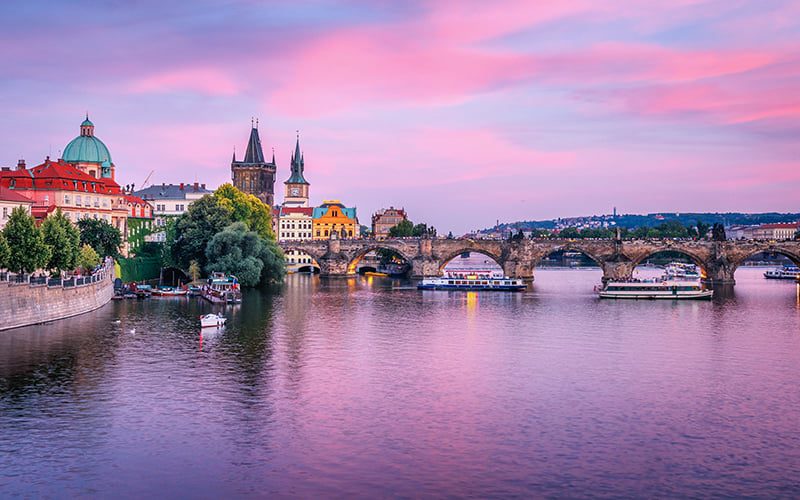
Prague’s main train station, Praha Hlavní Nádraží, with its domes is a great example of new art architecture. Prague’s other international train station, Nádraží Holešovice, is the departure point for trains to Berlin, Vienna and Budapest, and the city’s 2nd largest station. Located in the north of the city, Nádraží Holešovice is only a few minutes away from Wencelas Square on the C line, and it also has a connection to the city center by metro.
The fact that Prague has a direct rail connection to many European cities and provides good international service with high-speed and night trains makes transportation easier. City Night Line sleeper trains run from Prague to Germany.
You can use the Czech Pendolino, the country’s local high-speed train, which runs from the Austrian border to Vienna and circulates between Prague and the other major cities of the Czech Republic, Brno and Ostrava. The cheap public transport system in Prague is the best way to get around the city. Public transport that you can use metro, tram, bus and funicular.
You have to buy tickets (jízdenky) in advance and have them stamped when entering the tram, bus and metro. This process is valid for all types of public transport in the city. You can get tickets from ticket machines, tobacco shops, tourist information centers and any shops with the red and yellow DPP emblem. There are different types, from one-time to 3 days old.
With so much to explore and see for historical heritage buffs, the best way to understand where the beauty of this baroque gem comes from is to stroll on the Charles Bridge at dusk or paddle down the Vltava River . With its bridges, towers and high castles, Prague is a city where visitors to the city return home with unforgettable memories.
Prague’s main train station, Praha Hlavní Nádraží, with its domes is a great example of new art architecture. Prague’s other international train station, Nádraží Holešovice, is the departure point for trains to Berlin, Vienna and Budapest, and the city’s 2nd largest station. Located in the north of the city, Nádraží Holešovice is only a few minutes away from Wencelas Square on the C line, and it also has a connection to the city center by metro.
The fact that Prague has a direct rail connection to many European cities and provides good international service with high-speed and night trains makes transportation easier. City Night Line sleeper trains run from Prague to Germany.
You can use the Czech Pendolino, the country’s local high-speed train, which runs from the Austrian border to Vienna and circulates between Prague and the other major cities of the Czech Republic, Brno and Ostrava. The cheap public transport system in Prague is the best way to get around the city. Public transport that you can use metro, tram, bus and funicular.
You have to buy tickets (jízdenky) in advance and have them stamped when entering the tram, bus and metro. This process is valid for all types of public transport in the city. You can get tickets from ticket machines, tobacco shops, tourist information centers and any shops with the red and yellow DPP emblem. There are different types, from one-time to 3 days old.
With so much to explore and see for historical heritage buffs, the best way to understand where the beauty of this baroque gem comes from is to stroll on the Charles Bridge at dusk or paddle down the Vltava River . With its bridges, towers and high castles, Prague is a city where visitors to the city return home with unforgettable memories.













